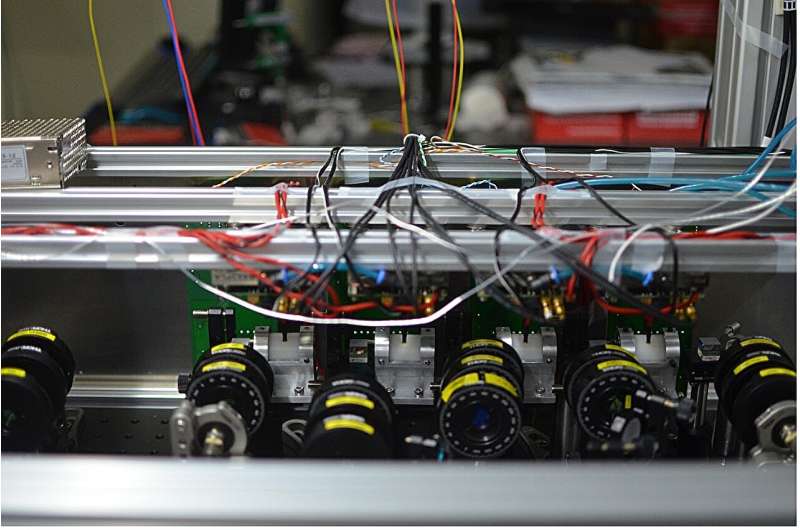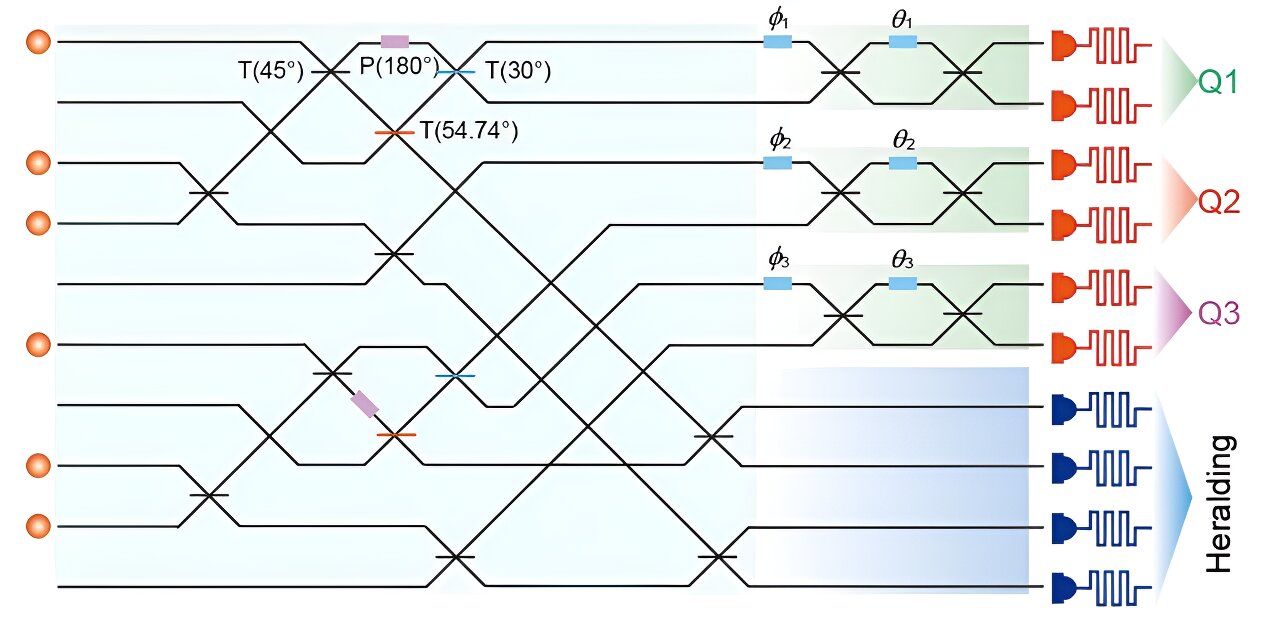Photonic quantum computers are computational tools that leverage quantum physics and utilize particles of light (i.e., photons) as units of information processing. These computers could eventually outperform conventional quantum computers in terms of speed, while also transmitting information across longer distances.
Despite their promise, photonic quantum computers have not yet reached the desired results, partly due to the inherently weak interactions between individual photons. In a paper published in Physical Review Letters, researchers at University of Science and Technology of China demonstrated a large cluster state that could facilitate quantum computation in a photonic system, namely three-photon entanglement.
“Photonic quantum computing holds promise due to its operational advantages at room temperature and minimal decoherence,” Hui Wang, co-author of the paper, told Phys.org.
“However, the inherent challenge lies in the weak interaction between single photons, hindering the realization of deterministic two-qubit gates essential for scalability. To address this issue, the concepts of fusion and percolation have emerged over the past two decades within our field.”
Past studies suggest that fusion and percolation could be scalable approaches to realize quantum computation in photonic systems without the need for deterministic entangling gates, such as those required by superconducting qubits and trapped ions. As part of their study, Wang and his colleagues employed a strategy that entails fusing small resource states, such as the heralded 3-GHZ state they demonstrated, into large-scale cluster states that are suitable for realizing measurement-based quantum computing.
“The percolation theorem dictates that success is achievable if the success probability of fusion gate exceeds a specific threshold,” Wang said.
“In this framework, the initial phase involves generating the necessary resource state, with the smallest essential state being the three-photon Greenberger-Horne-Zeilinger (3-GHZ) state. Two primary methods exist for deterministic 3-GHZ state generation: (i) utilizing single-photon emitters like quantum dots, which though theoretically deterministic, face efficiency limitations with current technologies; and (ii) near-deterministically generating entangled clusters in a heralded fashion, enabling instant validation of success without perturbing the target state.”

Of the two methods that generate a 3-GHZ state, the near-deterministic generation of entangled clusters in a heralded fashion currently appears to be the most promising. Employing this method, the researchers were able to this state from a single-photon source in a photonic chip.
Their work is a significant milestone on the path towards realizing fault-tolerant photonic quantum computing. Specifically, their efforts could accelerate the development of large-scale optical quantum computers that rely on 3-GHZ states to process quantum information.
“Our experimental setup necessitates six single photons for injection into a 10-mode passive interferometer,” Wang explained.
“Our implementation utilizes an InAs/GaAs quantum dot as the single-photon source. Noting this is the state-of-the-art single-photon source among all physical systems. The programmable interferometer, sourced from Quix, demonstrates an overall efficiency of 50%. Through the application of a specific unitary transformation, the resulting output state across ports 1-6 manifests as a dual-rail encoded heralded 3-GHZ state, contingent upon the detection of single photons in both ports and in just one of the ports.”
The first report of heralded single photons dates back to 1986, while the first heralded entangled photon pairs were realized in 2010. The recent work by Wang and his collaborators builds on these previous advances, demonstrating a large cluster state that could play a key role in enabling fault-tolerant, measurement-based quantum computing utilizing photonic chips.
Notably, the paper was published around the same time as two related studies by other teams, featured in Physical Review Letters and Nature Photonics, which gathered other impressive results. Collectively, these developments suggest that we are moving closer to the effective realization of fault-tolerant photonic quantum computers.
“In the foreseeable future, achieving a demonstration of a fusion gate surpassing the percolation threshold using eight single photons is within reach,” Wang added.
“Building upon the success of the heralded 3-GHZ state presented in this study, multiple 3-GHZ resource states can be amalgamated to form a more extensive entangled state. Furthermore, the exploration of large-scale entangled state generation on integrated quantum optical platforms is underway.”
More information:
Si Chen et al, Heralded Three-Photon Entanglement from a Single-Photon Source on a Photonic Chip, Physical Review Letters (2024). DOI: 10.1103/PhysRevLett.132.130603. On arXiv: DOI: 10.48550/arxiv.2307.02189
© 2024 Science X Network
Citation:
Demonstration of heralded three-photon entanglement on a photonic chip (2024, April 25)
retrieved 25 April 2024
from https://phys.org/news/2024-04-heralded-photon-entanglement-photonic-chip.html
This document is subject to copyright. Apart from any fair dealing for the purpose of private study or research, no
part may be reproduced without the written permission. The content is provided for information purposes only.


